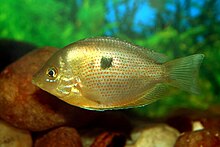| Orange chromide | |
|---|---|

| |
| Orange chromide from the Bharathapuzha River, India | |
| Conservation status | |
 Least Concern (IUCN 3.1) | |
| Scientific classification | |
| Domain: | Eukaryota |
| Kingdom: | Animalia |
| Phylum: | Chordata |
| Class: | Actinopterygii |
| Order: | Cichliformes |
| Family: | Cichlidae |
| Subfamily: | Etroplinae |
| Genus: | Pseudetroplus Bleeker, 1862 |
| Species: | P. maculatus |
| Binomial name | |
| Pseudetroplus maculatus (Bloch, 1795) | |
| Synonyms | |
| |
The orange chromide (Pseudetroplus maculatus ; more commonly Etroplus maculatus) is a species of cichlid fish that is endemic to freshwater and brackish streams, lagoons and estuaries in southern India and Sri Lanka. It is also known as pallathi (Malayalam: പള്ളത്തി) in Malayalam. The species is popular with fishkeeping hobbyists, and is kept frequently in aquariums. The species is part of the family Cichlidae and is included in subfamily Etroplinae. The orange chromide reaches a length of up to 8 cm (3.1 in).
Diet

The species co-occurs throughout its range with the green chromide (Etroplus suratensis). Orange chromides prey on the eggs and larvae of the green chromide and also act as a "cleaner fish" removing parasites from the larger green chromides in a cleaning symbiosis. The species also feeds on zooplankton and algae.
Parental care
Young orange chromides feed on mucous coating of their parents; this is essential for the small fry survival. During the feeding period, the parent fishes' mucous glands increase 34%.
References
- Abraham, R.; de Alwis Goonatilake, S.; Fernado, M.; Kotagama, O. (2019). "Etroplus maculatus". IUCN Red List of Threatened Species. 2019: e.T172481A60632931. doi:10.2305/IUCN.UK.2019-3.RLTS.T172481A60632931.en. Retrieved 5 December 2023.
- "Etroplus maculatus (Bloch, 1795)". Global Biodiversity Information Facility. Retrieved 8 December 2023.
- Pethiyagoda, R., Maduwage, K. & Manamendra-Arachchi, K. (2014): Validation of the South Asian cichlid genus Pseudetroplus Bleeker (Pisces: Cichlidae). Zootaxa, 3838 (5): 595–600.
- ^ Loiselle, P.V. (1995). The Cichlid Aquarium. Germany: Tetra Press. ISBN 1-56465-146-0.
- ^ Froese, Rainer; Pauly, Daniel (eds.). "Etroplus maculatus". FishBase. April 2017 version.
- Riehl, R.. & Baensch, H.A. (1995). Aquarium Atlas. Germany: Tetra Press. ISBN 3-88244-050-3.
- Gerking, Shelby D. (Apr 25, 2014). Feeding Ecology of Fish. Elsevier. p. 286. ISBN 9781483288529.
External links
 Media related to Pseudetroplus maculatus at Wikimedia Commons
Media related to Pseudetroplus maculatus at Wikimedia Commons
| Taxon identifiers | |
|---|---|
| Pseudetroplus maculatus | |
| Etroplus maculatus | |